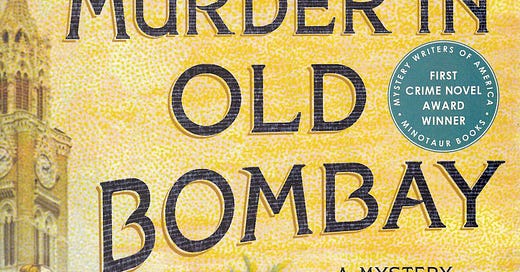Book Review: Murder in Old Bombay by Nev March (Minotaur Press, 2020)
Nev March’s Murder in Old Bombay is a deftly crafted historical mystery that blends the detective genre with rich historical fiction. It offers readers a suspenseful tale set against the backdrop of British colonial India. Winner of the Minotaur Books/Mystery Writers of America First Crime Novel Award, the novel is inspired by real events and steeped in cultural texture and emotional depth. It introduces a compelling new detective hero in Captain Jim Agnihotri, a man caught between identities, loyalties, and empires.
Set in 1892 Bombay, the novel opens with a shocking tragedy: two Parsi women fall to their deaths from the university clock tower in an apparent double suicide. The authorities quickly close the case, but the grieving widower, Adi Framji, remains unconvinced and hires Captain Jim to investigate. A former British Indian Army officer convalescing from wounds sustained on the frontier, Jim is a man with time on his hands and a mind sharpened by a love for Sherlock Holmes stories. What begins as a simple inquiry into a tragic event soon unravels into a dangerous web of secrets, lies, and colonial politics.
One of the novel’s greatest strengths lies in its protagonist. Jim Agnihotri—half-Indian, half-English, and of uncertain social standing—is a refreshingly original character. His mixed heritage and outsider status allow him to navigate both British and Indian societies with cautious insight, though he belongs entirely to neither. March portrays him with complexity and empathy; he is intelligent, thoughtful, and driven by a desire for justice, but questions of identity and belonging also burden him. His internal conflicts deepen the narrative and add gravitas to what might otherwise be a straightforward detective story.
The mystery at the novel’s heart is multi-layered and intricate, with numerous twists and red herrings. As Jim delves into the case, he uncovers various suspects, from manipulative relatives to dangerous revolutionaries and corrupt officials. March handles the plot confidently, balancing suspense with character development. The pacing is deliberate but never sluggish, allowing the reader to absorb the historical atmosphere while following the unraveling of clues.
The historical setting is another standout feature. March, born in India and now lives in the U.S., brings late 19th-century Bombay vividly to life. Her descriptions of bustling bazaars, elite clubs, colonial mansions, and Parsi households are meticulously detailed and immersive. The novel also examines the rigid social hierarchies of the time, including tensions between British rulers and Indian subjects and among India’s own religious and ethnic communities. These themes, which are not just window dressing but central to the narrative and inform the characters’ motives and actions, resonate with contemporary issues of identity, power dynamics, and cultural diversity.
At its core, Murder in Old Bombay is also a novel about family, loss, and resilience. The Framji family, particularly Adi and his younger sister Diana, are portrayed with warmth and nuance. Diana, in particular, emerges as a standout character—spirited, intelligent, and unwilling to be constrained by societal expectations. Her evolving relationship with Jim adds romantic tension and emotional resonance to the story without overpowering the central mystery.
If there is a critique to be made, it is that the novel’s length (nearly 400 pages) occasionally leads to moments of repetition or meandering. Some secondary plotlines, such as Jim’s stint in a remote village or his reflections on his military service, while interesting in themselves, slightly detract from the central investigation. For instance, Jim's time in the remote village provides a deeper understanding of his character and the societal dynamics of the time, but it may slow down the pace of the central mystery. Still, these digressions contribute to the novel’s rich character development and thematic scope.
March’s writing style is elegant and evocative, with a tone that feels authentically of its time while still accessible to modern readers. Her incorporation of real historical incidents (the novel is loosely based on the actual case of Beryl and Belinda Lalkaka, two Parsi sisters who died under mysterious circumstances in 1891) lends the story an added layer of intrigue and poignancy. She seamlessly weaves together fact and fiction, shedding light on a fascinating and underexplored period of Indian history through the lens of crime fiction.
Murder in Old Bombay succeeds both as a mystery and as a historical novel. It introduces a charismatic sleuth whose outsider perspective gives him unique insight into the criminal underworld and the social elite. It also paints a vivid picture of a colonial society on the cusp of change, where questions of identity, loyalty, and justice loom. The novel's exploration of these themes can spark meaningful discussions about cultural identity, social justice, and the human condition. Readers who enjoy richly layered mysteries, from the works of Sujata Massey to the Victorian tales of Anne Perry, will find much to admire here.
In her debut, Nev March offers a gripping whodunit and a thoughtful meditation on cultural hybridity and the enduring human search for truth and connection. Murder in Old Bombay is an auspicious beginning to what promises to be a compelling series.



